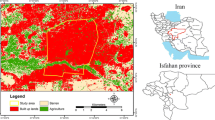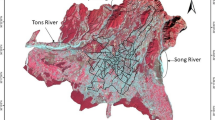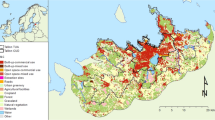Abstract
The present study attempts to simulate land surface temperature (LST) as a function of built-up density using an artificial neural network (ANN) algorithm. The LST was retrieved from Landsat thermal datasets for years 2000, 2010, and 2019 using a single channel algorithm. The retrieved LST was validated using downscaled MODIS LST products of corresponding dates and an average root-mean-square error (RMSE) of 1.3 °C and 1.9 °C was obtained on winter and summer datasets, respectively. The ANN was trained using corresponding built-up density and LST values for the year 2000, 2010, and 2019. The mean absolute error (MAE) of 1.1 °C and 0.7 °C was achieved on summer and winter training datasets, respectively, while on summer and winter testing datasets MAE of 1.5 °C and 0.9 was obtained. Various urban growth scenarios in the year 2029 were simulated using sim weight which is a nonparametric instance-based machine learning algorithm, based on K nearest neighbour procedure. The simulated built-up densities for the year 2029 were input into the trained ANN and LST patterns for the year 2029 were predicted. Analysis of the results showed that for Dehradun city which is located in a humid subtropical climate zone in India, compact urban growth led to lesser areas having LST greater than 42 °C in summers, as compared to other urban growth patterns.










Similar content being viewed by others
References
Agam, N., Kustas, W. P., Anderson, M. C., Li, F., & Neale, C. M. (2007). A vegetation index based technique for spatial sharpening of thermal imagery. Remote Sensing of Environment, 107(4), 545–558.
Ahmed, B., Kamruzzaman, M., Zhu, X., Rahman, M., & Choi, K. (2013). Simulating land cover changes and their impacts on land surface temperature in dhaka Bangladesh. Remote Sensing, 5(11), 5969–5998. https://doi.org/10.3390/rs5115969
Ahmed, S. (2017). Assessment of urban heat islands and impact of climate change on socioeconomic over Suez Governorate using remote sensing and GIS techniques. The Egyptian Journal of Remote Sensing and Space Science, 21(1), 15–25.
Akbari, H., & Kolokotsa, D. (2016). Three decades of urban heat islands and mitigation technologies research. Energy and Buildings, 133, 834–842.
Anderson, J.R., Hardy, E.E., Roach, J.T., & Witmer, R.E. (1976). A land use and land cover classification system for use with remote sensor data. In USGS Professional Paper 964, USA.
Aram, F., García, E. H., Solgi, E., & Mansournia, S. (2019). Urban green space cooling effect in cities. Heliyon, 5(4), e01339.
Arora, M. K., Das Gupta, A. S., & Gupta, R. P. (2004). An artificial neural netwok approach for landslide hazard zonation in the Bhagirathi (Ganga) valley Himalayas. International Journal of Remote Sensing, 25(3), 559–572.
Balew, A., & Korme, T. (2020). Monitoring land surface temperature in Bahir Dar city and its surrounding using Landsat images. The Egyptian Journal of Remote Sensing and Space Science. https://doi.org/10.1016/j.ejrs.2020.02.001
Bindhu, V. M., Narasimhan, B., & Sudheer, K. P. (2013). Development and verification of a non-linear disaggregation method (NL-DisTrad) to downscale MODIS land surface temperature to the spatial scale of Landsat thermal data to estimate evapotranspiration. Remote Sensing of Environment, 135, 118–129.
Bisquert, M., Sánchez, J. M., & Caselles, V. (2016). Evaluation of disaggregation methods for downscaling MODIS land surface temperature to Landsat spatial resolution in Barrax test site. IEEE Journal of Selected Topics in Applied Earth Observations and Remote Sensing, 9(4), 1430–1438.
Brunsdon, C., Fotheringham, A. S., & Charlton, M. E. (1996). Geographically weighted regression: A method for exploring spatial nonstationarity. Geographical Analysis, 28(4), 281–298.
Bununu, Y. A. (2017). Integration of Markov chain analysis and similarity-weighted instance-based machine learning algorithm (SimWeight) to simulate urban expansion. International Journal of Urban Sciences, 21(2), 217–237. https://doi.org/10.1080/12265934.2017.1284607
Congalton, R. G., & Green, K. (1999). Assessing the accuracy of remotely sensed data: Principles and practices. CRC Press, Inc.
da Silva, A. R., & Fotheringham, A. S. (2016). The multiple testing issue in geographically weighted regression. Geographical Analysis, 48(3), 233–247.
Deilami, K., Kamruzzaman, M., & Liu, Y. (2018). Urban heat island effect: A systematic review of spatio-temporal factors, data, methods, and mitigation measures. International Journal of Applied Earth Observation and Geoinformation, 67, 30–42.
Feng, Y., Li, H., Tong, X., Chen, L., & Liu, Y. (2018). Projection of land surface temperature considering the effects of future land change in the Taihu Lake Basin of China. Global and Planetary Change, 167, 24–34. https://doi.org/10.1016/j.gloplacha.2018.05.007
Firozjaei, M. K., Kiavarz, M., Alavipanah, S. K., Lakes, T., & Qureshi, S. (2018). Monitoring and forecasting heat island intensity through multi-temporal image analysis and cellular automata-Markov chain modelling: A case of Babol city. Iran. Ecological Indicators, 91, 155–170.
Gohain, K. J., Mohammad, P., & Goswami, A. (2020). Assessing the impact of land use land cover changes on land surface temperature over Pune city, India. Quaternary International, 575, 259–269.
Guha, S., Govil, H., Dey, A., & Gill, N. (2018). Analytical study of land surface temperature with NDVI and NDBI using Landsat 8 OLI and TIRS data in Florence and Naples city Italy. European Journal of Remote Sensing, 51(1), 667–678.
Guha, S., Govil, H., & Diwan, P. (2019). Analytical study of seasonal variability in land surface temperature with normalized difference vegetation index, normalized difference water index, normalized difference built-up index, and normalized multiband drought index. Journal of Applied Remote Sensing, 13(2), 024518.
Guha, S., Govil, H., & Mukherjee, S. (2017). Dynamic analysis and ecological evaluation of urban heat islands in Raipur city. India. Journal of Applied Remote Sensing, 11(3), 036020.
Guo, L., Liu, R., Men, C., Wang, Q., Miao, Y., & Zhang, Y. (2019). Quantifying and simulating landscape composition and pattern impacts on land surface temperature: A decadal study of the rapidly urbanizing city of Bei Jing, China. Science of the Total Environment, 654, 430–440.
Hang, H. T., & Rahman, A. (2018). Characterization of thermal environment over heterogeneous surface of National Capital Region (NCR), India using LANDSAT-8 sensor for regional planning studies. Urban Climate, 24, 1–18.
Haykin, S. (1999). Neural networks: A comprehensive foundation. Prentice Hall.
Hoffmann, E. M., Konerding, V., Nautiyal, S., & Buerkert, A. (2019). Is the push-pull paradigm useful to explain rural-urban migration? A case study in. Migration Session, 3, 1–22.
Jeganathan, C., Hamm, N. A. S., Mukherjee, S., Atkinson, P. M., Raju, P. L. N., & Dadhwal, V. K. (2011). Evaluating a thermal image sharpening model over a mixed agricultural landscape in India. International Journal of Applied Earth Observation and Geoinformation, 13(2), 178–191.
Jiménez-Munoz, J. C., & Sobrino, J. A. (2003). A generalized single-channel method for retrieving land surface temperature from remote sensing data. Journal of Geophysical Research: Atmospheres. https://doi.org/10.1029/2003jd003480
Jiménez-Muñoz, J. C., Sobrino, J. A., Skoković, D., Mattar, C., & Cristóbal, J. (2014). Land surface temperature retrieval methods from Landsat-8 thermal infrared sensor data. IEEE Geoscience and Remote Sensing Letters, 11(10), 1840–1843.
Kanungo, D. P., et al. (2006). A comparative study of conventional ANN black box, fuzzy and combined neural and fuzzy weighting procedures for landslide susceptibility zonation in Darjeeling Himalayas. Engineering Geology, 85, 347–366.
Kavzoglu, T., & Mather, P. M. (2003). The use of backpropagating artificial neural networks in land cover classification. International Journal of Remote Sensing, 24(23), 4907–4938. https://doi.org/10.1080/0143116031000114851
Kumar, S. (2004). Neural networks: A classroom approach. Tata McGraw-Hill Education.
Kumar, K. S., Bhaskar, P. U., & Kumari, K. P. (2018). A novel approach for prediction of future environmental impacts of urban growth. International Journal of Civil Engineering and Technology, 9(4), 1208–1219.
Kustas, W. P., Norman, J. M., Anderson, M. C., & French, A. N. (2003). Estimating subpixel surface temperatures and energy fluxes from the vegetation index–radiometric temperature relationship. Remote Sensing of Environment, 85(4), 429–440.
Li, X., Zhou, W., & Ouyang, Z. (2013b). Relationship between land surface temperature and spatial pattern of greenspace: What are the effects of spatial resolution? Landscape and Urban Planning, 114, 1–8.
Li, Z. L., Tang, B. H., Wu, H., Ren, H., Yan, G., Wan, Z., Trigo, I. F., & Sobrino, J. A. (2013a). Satellite-derived land surface temperature: Current status and perspectives. Remote Sensing of Environment, 131, 14–37.
Maduako. (2015). Simulation and prediction of land surface temperature (LST) dynamics within Ikom City in Nigeria using artificial neural network (ANN). Journal of Remote Sensing & GIS, 05(01), 1–7. https://doi.org/10.4172/2469-4134.1000158
Maithani, S. (2015). Neural networks-based simulation of land cover scenarios in Doon valley India. Geocarto International, 30(2), 163–185. https://doi.org/10.1080/10106049.2014.927535
Maithani, S., Arora, M. K., & Jain, R. K. (2010). An artificial neural network based approach for urban growth zonation in Dehradun city India. Geocarto International, 25(8), 663–681.
Maithani, S., Begum, A., Kumar, P., & Kumar, A. S. (2017). Simulation of peri-urban growth dynamics using weights of evidence approach. Geocarto International. https://doi.org/10.1080/10106049.2017.1319425
Maithani, S., Nautiyal, G., & Sharma, A. (2020). Investigating the effect of lockdown during COVID-19 on Land Surface temperature: study of Dehradun City, India. Journal of the Indian Society of Remote Sensing, 48(9), 1297–1311. https://doi.org/10.1007/s12524-020-01157-w
Mather, P. M. (1999). Computer processing of remotely sensed images: An introduction. John Wiley & Sons.
Mathew, A., Khandelwal, S., & Kaul, N. (2016). Spatial and temporal variations of urban heat island effect and the effect of percentage impervious surface area and elevation on land surface temperature: study of Chandigarh City. Sustainable Cities and Society. https://doi.org/10.1016/j.scs.2016.06.018
Mathew, A., Khandelwal, S., & Kaul, N. (2017). Land surface temperature ( LST ) is one of the principal parameters for the analysis of. Sustainable Cities and Society. https://doi.org/10.1016/j.scs.2017.07.013
Meng, X., Meng, F., Zhao, Z., & Yin, C. (2021). Prediction of urban heat island effect over Jinan City using the markov-cellular automata model combined with urban biophysical descriptors. Journal of the Indian Society of Remote Sensing, 49(4), 997–1009. https://doi.org/10.1007/s12524-020-01274-6
Mohammad, P., & Goswami, A. (2021). A spatio-temporal assessment and prediction of surface urban heat island intensity using multiple linear regression techniques over Ahmedabad City, Gujarat. Journal of the Indian Society of Remote Sensing, 49(5), 1091–1108.
Mukherjee, S., Joshi, P. K., & Garg, R. D. (2015). Evaluation of LST downscaling algorithms on seasonal thermal data in humid subtropical regions of India. International Journal of Remote Sensing, 36(10), 2503–2523.
Mukherjee, S., Joshi, P. K., & Garg, R. D. (2017). Analysis of urban built-up areas and surface urban heat island using downscaled MODIS derived land surface temperature data. Geocarto International, 32(8), 900–918.
Mushore, T. D., Odindi, J., Dube, T., & Mutanga, O. (2017). Prediction of future urban surface temperatures using medium resolution satellite data in Harare metropolitan city, Zimbabwe. Building and Environment, 122, 397–410.
Mustafa, E. K., Liu, G., Abd El-Hamid, H. T., & Kaloop, M. R. (2019). Simulation of land use dynamics and impact on land surface temperature using satellite data. GeoJournal, 1–19.
Mustafa, E. K., Co, Y., Liu, G., Kaloop, M. R., Beshr, A. A., Zarzoura, F., & Sadek, M. (2020). Study for predicting land surface temperature (LST) using landsat data: a comparison of four algorithms. Advances in Civil Engineering. https://doi.org/10.1155/2020/7363546
Mustafa, E. K., Liu, G., Abd El-Hamid, H. T., & Kaloop, M. R. (2021). Simulation of land use dynamics and impact on land surface temperature using satellite data. GeoJournal, 86(3), 1089–1107. https://doi.org/10.1007/s10708-019-10115-0
Nautiyal, G., Maithani, S., & Sharma, A. (2021). Exploring the relationship between spatio-temporal land cover dynamics and surface temperature over dehradun urban agglomeration, India. Journal of the Indian Society of Remote Sensing, 49(6), 1307–1318. https://doi.org/10.1007/s12524-021-01323-8
Nurwanda, A., & Honjo, T. (2020). The prediction of city expansion and land surface temperature in Bogor City, Indonesia. Sustainable Cities and Society. https://doi.org/10.1016/j.scs.2019.101772
Oshan, T. M., Li, Z., Kang, W., Wolf, L. J., & Fotheringham, A. S. (2019a). MGWR: A Python implementation of multiscale geographically weighted regression for investigating process spatial heterogeneity and scale. ISPRS International Journal of Geo-Information, 8(6), 269.
Oshan, T., Wolf, L. J., Fotheringham, A. S., Kang, W., Li, Z., & Yu, H. (2019b). A comment on geographically weighted regression with parameter-specific distance metrics. International Journal of Geographical Information Science, 33(7), 1289–1299.
Pontius, R. G., Cornell, J. D., & Hall, C. A. S. (2001). Modeling the spatial pattern of land-use change with GEOMOD2: Application and validation for Costa Rica. Agriculture, Ecosystems and Environment, 85(1–3), 191–203. https://doi.org/10.1016/S0167-8809(01)00183-9
Pontius, R. G., & Pacheco, P. (2004). Calibration and validation of a model of forest disturbance in the Western Ghats, India 1920–1990. GeoJournal, 61(4), 325–334. https://doi.org/10.1007/s10708-004-5049-5
Prata, A. J., Caselles, V., Coll, C., Sobrino, J. A., & Ottlé, C. (1995). Thermal remote sensing of land surface temperature from satellites: Current status and future prospects. In Remote Sensing Reviews.
Rahman, M. T., Aldosary, A. S., & Mortoja, M. G. (2017). Modeling future land cover changes and their effects on the land surface temperatures in the Saudi Arabian eastern coastal city of Dammam. Land. https://doi.org/10.3390/land6020036
Ranjan, A. K., Anand, A., Kumar, P. B. S., Verma, S. K., & Murmu, L. (2017). Prediction of land surface temperature using artificial neural network in conjunction with geoinformatics technology within Sun City Jodhpur ( Rajasthan ) India. Asian Journal of Geoinformatics, 17(3), 14–23.
Rodriguez-Galiano, V., Pardo-Igúzquiza, E., Sanchez-Castillo, M., Chica-Olmo, M., & Chica-Rivas, M. (2012). Downscaling Landsat 7 ETM+ thermal imagery using land surface temperature and NDVI images. International Journal of Applied Earth Observation and Geoinformation, 18, 515–527.
Rosati, A., Fedel, M., & Rossi, S. (2020). NIR reflective pigments to mitigate the urban heat islands effect (UHIE). In E3S Web of Conferences .172: 03006. EDP Science
Sangermano, F., Eastman, J. R., & Zhu, H. (2010). Similarity weighted instance-based learning for the generation of transition potentials in land use change modeling. Transactions in GIS, 14(5), 569–580. https://doi.org/10.1111/j.1467-9671.2010.01226.x
Santamouris, M., & Kolokotsa, D. (2016). Urban climate mitigation techniques. Routledge.
Sekertekin, A., & Zadbagher, E. (2021). Simulation of future land surface temperature distribution and evaluating surface urban heat island based on impervious surface area. Ecological Indicators, 122, 107230.
Shanmugapriya, E. V., & Geetha, P. (2018). A framework for the prediction of land surface temperature using artificial neural network and vegetation index. Proceedings of the 2017 IEEE International Conference on Communication and Signal Processing, ICCSP 2017, 2018-Janua, 1313–1317. https://doi.org/10.1109/ICCSP.2017.8286595
Sharma, A., Singh, O. P., & Saklani, M. M. (2012). Climate of Dehradun. In Indian Meteorological Department, Ministry of Earth Sciences
Sherafati, S., Saradjian, M. R., & Rabbani, A. (2018). Assessment of surface urban heat island in three cities surrounded by different types of land-cover using satellite images. Journal of the Indian Society of Remote Sensing, 46(7), 1013–1022.
Singh, O., Arya, P., & Chaudhary, B. S. (2013). On rising temperature trends at Dehradun in Doon valley of Uttarakhand India. Journal of Earth System Science, 122(3), 613–622.
Song, J., Du, S., Feng, X., & Guo, L. (2014). The relationships between landscape compositions and land surface temperature: Quantifying their resolution sensitivity with spatial regression models. Landscape and Urban Planning, 123, 145–157. https://doi.org/10.1016/j.landurbplan.2013.11.014
Sun, R., & Chen, L. (2017). Effects of green space dynamics on urban heat islands: Mitigation and diversification. Ecosystem Services, 23(July 2016), 38–46. https://doi.org/10.1016/j.ecoser.2016.11.011
Taleghani, M. (2018). Outdoor thermal comfort by different heat mitigation strategies-A review. Renewable and Sustainable Energy Reviews, 81, 2011–2018.
Tayyebi, A., & Pijanowski, B. C. (2014). Modeling multiple land use changes using ANN, CART and MARS: Comparing tradeoffs in goodness of fit and explanatory power of data mining tools. International Journal of Applied Earth Observation and Geoinformation, 28(1), 102–116. https://doi.org/10.1016/j.jag.2013.11.008
Tran, D. X., Pla, F., Latorre-Carmona, P., Myint, S. W., Caetano, M., & Kieu, H. V. (2017). Characterizing the relationship between land use land cover change and land surface temperature. ISPRS Journal of Photogrammetry and Remote Sensing, 124, 119–132.
Voogt, J. A., & Oke, T. R. (2003). Thermal remote sensing of urban climates. Remote Sensing of Environment, 86(3), 370–384.
Yu, X., Guo, X., & Wu, Z. (2014). Land surface temperature retrieval from Landsat 8 TIRS—Comparison between radiative transfer equation-based method, split window algorithm and single channel method. Remote Sensing, 6(10), 9829–9852.
Zakšek, K., & Oštir, K. (2012). Downscaling land surface temperature for urban heat island diurnal cycle analysis. Remote Sensing of Environment, 117, 114–124.
Zhang, W., Jiang, L., Cui, Y., Xu, Y., Wang, C., Yu, J., Streets, D. G., & Lin, B. (2019). Effects of urbanization on airport CO2 emissions: A geographically weighted approach using nighttime light data in China. Resources, Conservation and Recycling, 150, 104454.
Zhao, C., Jensen, J., Weng, Q., & Weaver, R. (2018). A geographically weighted regression analysis of the underlying factors related to the surface urban heat island phenomenon. Remote Sensing, 10(9), 1428.
Zubair, O. A., Ji, W., & Weilert, T. E. (2017). Modeling the impact of urban landscape change on urban wetlands using similarityweighted instance-based machine learning and Markov model. Sustainability (switzerland). https://doi.org/10.3390/su9122223
Acknowledgements
We gratefully acknowledge Director, IIRS for his guidance and support.We gratefully acknowledge Department of Science and Technology, Government of India for providing support through the INSPIRE fellowship to Ms. Garima Nautiyal (second author), Doon University
Author information
Authors and Affiliations
Corresponding author
Ethics declarations
Conflict of interest
The authors declare that they have no conflict of interest.
Additional information
Publisher's Note
Springer Nature remains neutral with regard to jurisdictional claims in published maps and institutional affiliations.
About this article
Cite this article
Maithani, S., Nautiyal, G., Sharma, A. et al. Simulation of Land Surface Temperature Patterns Over Future Urban Areas—A Machine Learning Approach. J Indian Soc Remote Sens 50, 2145–2162 (2022). https://doi.org/10.1007/s12524-022-01590-z
Received:
Accepted:
Published:
Issue Date:
DOI: https://doi.org/10.1007/s12524-022-01590-z




